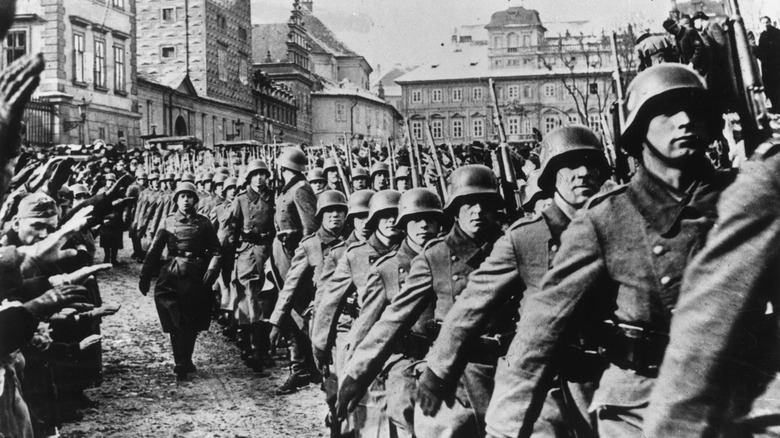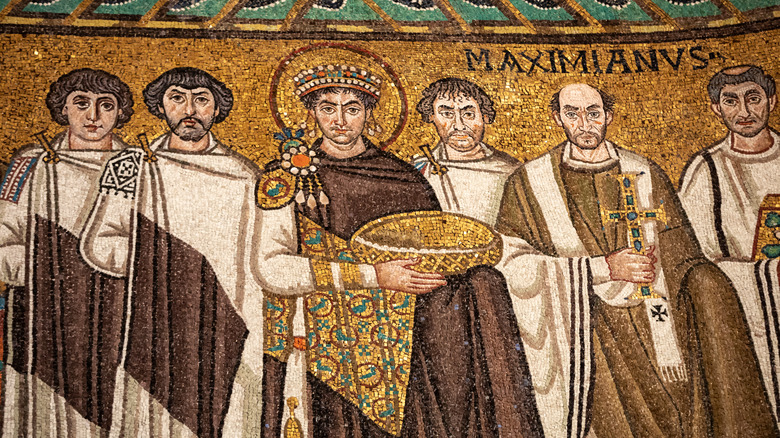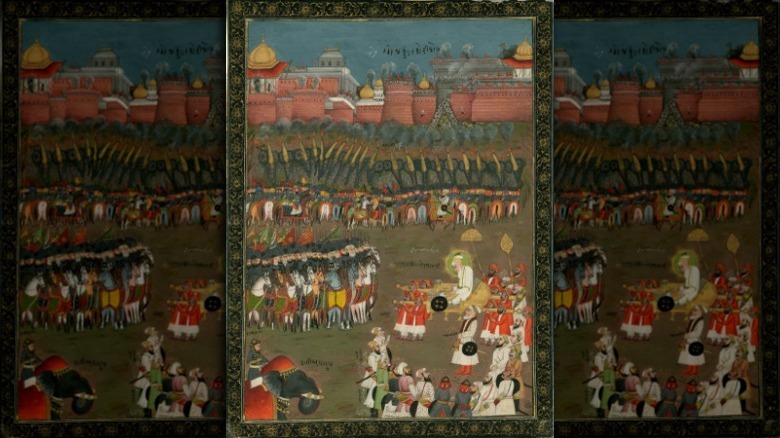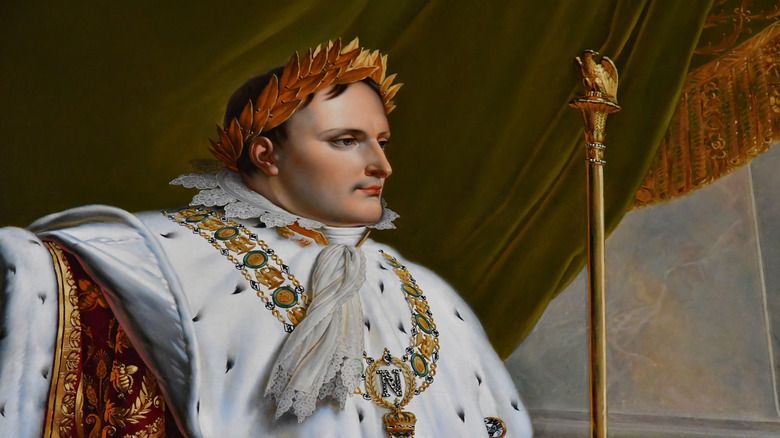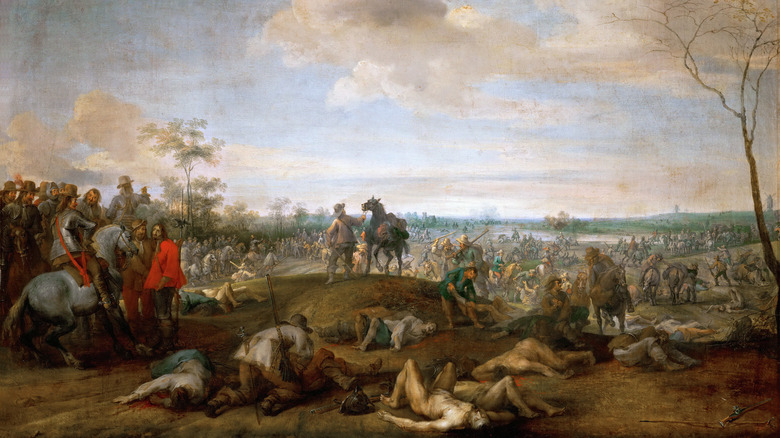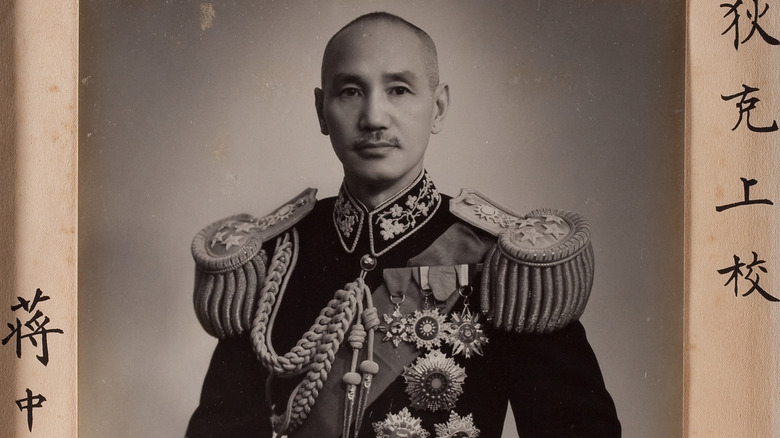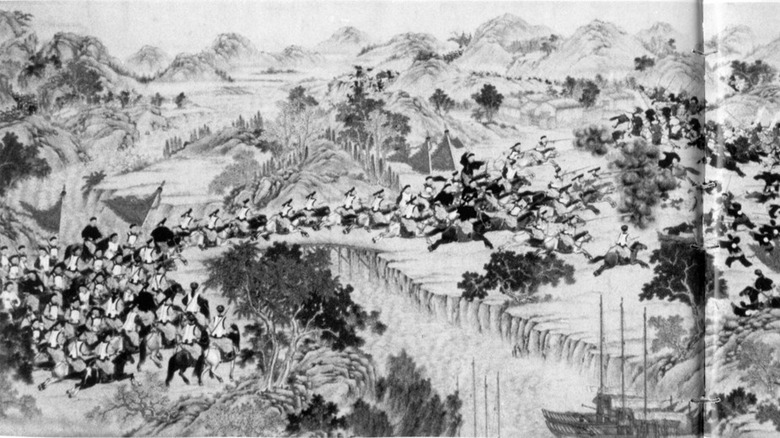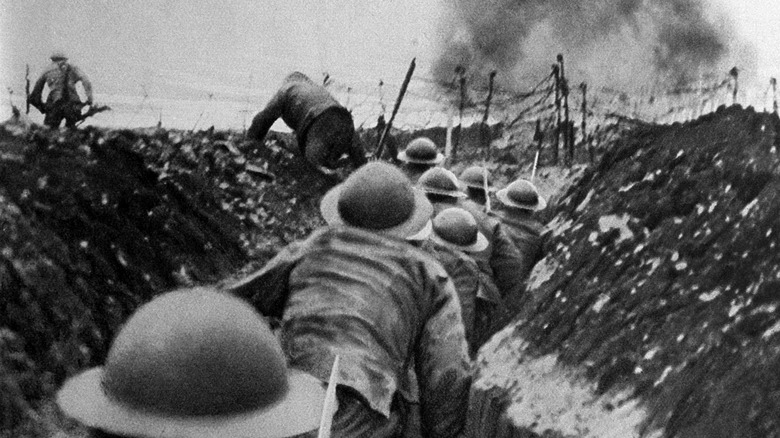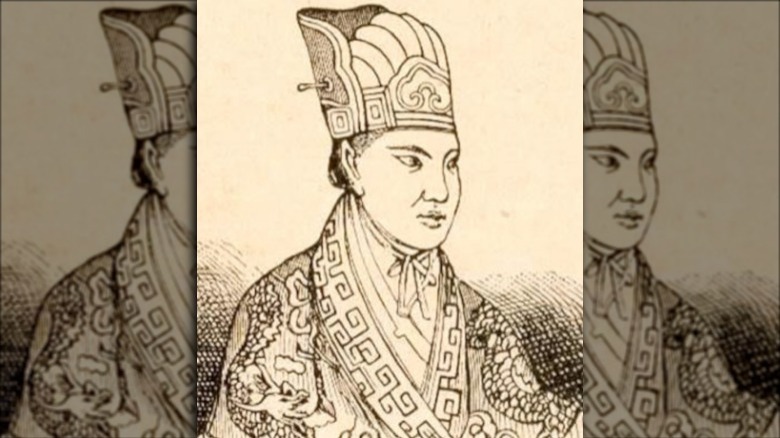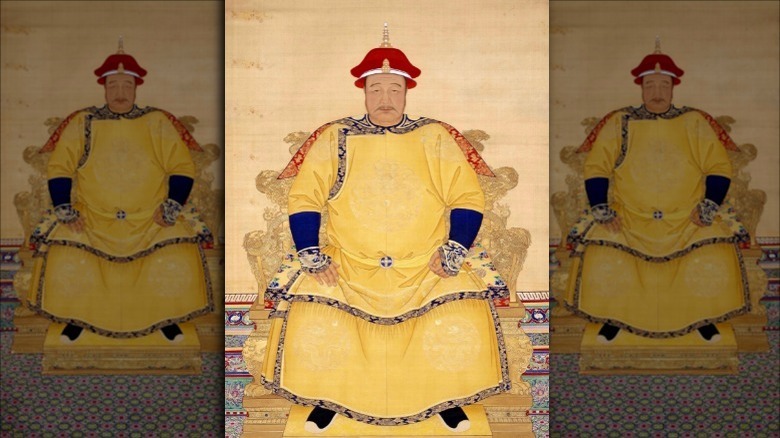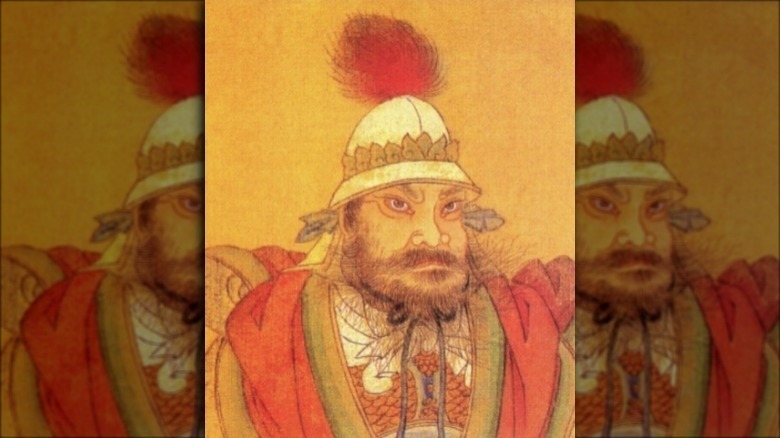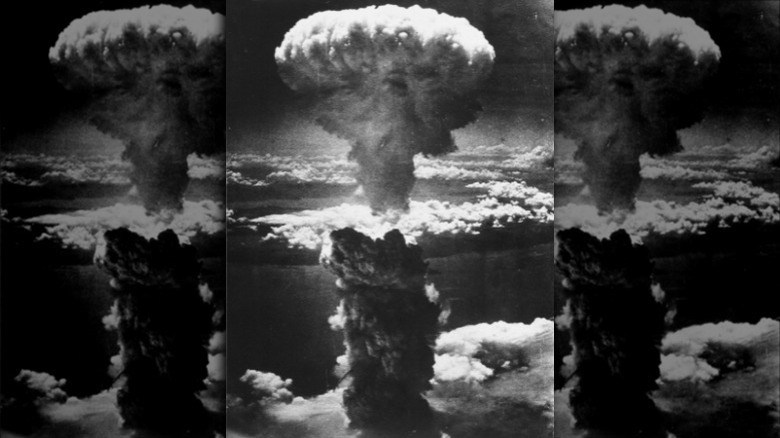Deadliest Wars In History
There have been few constants throughout human history. Sadly, one of the most reliable of those constants is warfare. Throughout our entire existence, war has been an inescapable factor. It has shaped our history, our culture, and our environment in infinite ways. There are competing theories as to the reasons behind humanity's warlike nature, with some believing we're biologically or psychologically programmed for war, while others argue it's social and institutional forces that push us to fight each other.
Whatever the cause of warfare, there is little doubt that it has been the mankind's deadliest endeavor. War is, after all, the business of killing other people for some perceived gain — territory, treasure, power. But there's a difference between the vague notion that war equals death and seeing the stark figures. And while we think of modern warfare as being particularly devastating, the fact is humanity has always been pretty clever about killing their enemies in battle — though modern technology has made generating war casualties a much more efficient process. Counting up the deaths caused by war offers a sad tour of world history and insight into the sheer brutality mankind can unleash on itself. Here are the deadliest wars in history.
The Moorish Wars: 5 million deaths
When we think of the cost of warfare, we tend to focus on modern battlefields. The sheer weight of equipment, weaponry, and technology combined with the incredibly high death rate caused by modern war makes it seem like military action only recently became incredibly dangerous. The reality is that given enough time and motivation, humanity has always been very skilled at destroying itself. And no empire was better at waging war than the Roman Empire in all its different guises. By the 6th century A.D., the Western Roman Empire was no more, but the Eastern portion endured as the Byzantine Empire, per The Great Courses Daily. As noted by History Collection, in 534, the Byzantines managed to re-conquer northern Africa from the Vandals. But as any student of war will tell you, winning battles is one thing; holding onto territory is something else entirely.
The native Moors and Berbers immediately launched a rebellion against their Roman masters. The Byzantines managed to control the situation until a plague erupted throughout the empire in the 540s. When the Roman Magister Militum Solomon was killed in battle in 544, things went from bad to worse. There followed a seemingly endless series of battles, mutinies, and bloody invasions. As historian Peter Heather writes in "Rome Resurgent," it took Rome 15 years to finally solidify its control of the region — a lengthy war that took an estimated 5 million lives.
The Mughal–Maratha Wars: 5,600,000 deaths
In the 17th century, India was dominated by the Muslim Mughal Empire. As explained by Odyssey Traveler, the empire was decentralized, with the Mughal Emperor Aurangzeb reliant on the loyalty of lesser nobles throughout his territory. That opened an opportunity for the smaller Hindu population to launch a war for independence that would eventually form the Maratha Empire.
History Collection notes that the Mughals had every advantage, including a larger army and an established government. Emperor Aurangzeb's strategy was simple: Overwhelm his smaller enemy with excessive force. But the Marathas employed guerrilla tactics that slowed the Mughal army to a crawl, forcing them to spend years to conquer small areas — even single forts. HistoriaRex notes that Emperor Aurangzeb often ordered his forces to capture areas no matter the cost, resulting in incredibly high casualties for the Mughal army. Nevertheless, the Mughal Empire appeared victorious in 1689 when it captured and executed the Maratha King, Sambhaji Bhosale.
Instead, Sambhaji's death inspired redoubled resistance, and the Marathas began to win. The tide had turned, and for several grinding decades, the Marathas slowly pushed the Mughals back, eventually capturing Delhi in 1758 and eradicating the Mughal Empire almost entirely. This slow grinding war — the longest war in India's history — produced nearly 6 million deaths.
The Napoleonic Wars: 6 million deaths
Napoleon Bonaparte's meteoric rise through the ranks of French power was remarkable, especially considering he was actually born in Corsica and didn't speak French until he learned the language as a schoolboy, per History. After making a name for himself as a military leader, Napoleon seized power from the Directory that ruled France since the French Revolution, eventually proclaiming himself emperor. He promptly went to war with just about every single major European power in a series of conflicts known as the Napoleonic Wars, and they were catastrophic in terms of loss of life.
Estimates vary, but as many as 6 million people died as a result of these conflicts. One factor was Napoleon's willingness to sacrifice his soldiers. History notes that when Napoleon's political situation was threatened in 1799, he abandoned his army in Egypt without hesitation. Elsewhere, War History Online notes that his ill-advised invasion of Russia in 1812 resulted in more than 500,000 men — nearly his entire army — dying of exposure, starvation, and good old-fashioned bullets. Napoleon's tactics were also often extremely daring, resulting in terrible losses. At the same time, improved technology in firearms and artillery meant that pitched battles were exponentially deadlier, resulting in shocking casualties on a regular basis between 1802 and 1815.
The Thirty Years' War: 8 million deaths
The Thirty Years' War officially lasted from 1618 to 1648, although the roots of the conflict began much earlier. What began as a religious civil war between Catholic and Protestant states in the Holy Roman Empire — which was actually just a loose confederation of small kingdoms — spread to involve just about every major power in Europe at the time. Amid the clash of ideologies, each tried to push events in ways that benefited their own interests.
Thirty years is a long time to wage war. As History Collection reports, all that endless fighting resulted in some eye-popping casualty stats: It's estimated that as many as 8 million people died during those bloody decades. According to Smithsonian Magazine, these losses weren't evenly distributed. Since the fighting was concentrated within the borders of the old Holy Roman Empire, what is modern-day Germany suffered the most — about 20 percent of the entire population of the region died during the war.
As noted by Live Science, proportionately the Thirty Years' War was deadlier than the Black Death and World War II. This explains the fact that archaeologists keep finding enormous mass graves containing thousands of soldiers from the conflict. Indeed, Europe was forever changed by this conflict — not least because of the immense loss of life that left huge vacuums in society.
The Chinese Civil War: 8 million deaths
China had one heck of a 20th century. In 1900, it was a backward empire ruled by the Qing dynasty. By 1999, it was a firmly communist nation and a burgeoning world power. And in between all of this upheaval was a lot of death.
The Chinese Civil War broke out between the nationalist Kuomintang (KMT) led by Chiang Kai-shek and the Chinese Communist Party (CCP) led by Mao Zedong. Owlcation reports that the war was fought in two phases — the first lasted from 1927 until 1936, when the Japanese invaded China, bringing the chaos of World War II to China. The KMT and CCP officially put aside their differences in the interest of defending their country, but as reported by Britannica, they still worked against each other. When Japan was defeated, the KMT and CCP raced to resume hostilities.
And those hostilities were horrifying. According to WorldAtlas, this lengthy interrupted civil war cost an estimated 8 million deaths. Not only that but there might be a bloody addendum to this chapter of history. Per the Council on Foreign Relations, the People's Republic of China has never accepted Taiwan's independence and has long advocated that reunification is inevitable. Of course, that reunification may involve more war and more deaths, Forbes reports.
The Russian Civil War: 9 Million deaths
World War I was a disaster for the entire world, but some countries fared better than others. The Russian Empire was emphatically not one of the countries that fared better. As noted by Britannica, under the questionable leadership of Emperor Nicholas II, the Russian army was ill-equipped and poorly led. Military disasters and economic failures led to Nicholas abdicating in early 1917 and sent Russia spiraling into civil war.
History Collection explains that the Russian Civil War was fought mainly between the Bolsheviks, led by Vladimir Lenin, and the White Army — a coalition of forces opposed to the communists. Between 1917 and 1922, a stunning 9 million people died in the conflict as these groups fought over the carcass of the huge Russian Empire. However, it should be noted that this was a time of chaos, and records were spotty. Some estimates go as high as 12 million, especially if you consider the devastating famine and other consequences of the conflict that battered a country that had already weathered severe shocks during World War I. The Russian Civil War was so bloody, in fact, that it holds the dubious world-record highest death toll from a civil war by Guinness World Records.
The Dungan Revolt: 10 million deaths
Sometimes referred to as the Tungan Rebellion or simply the Muslim Rebellion, this was one of the bloodiest conflicts in China's history. Contrary to what many Westerners think, China is not an ethnically homogeneous country — it's a huge territory populated by a large number of different groups of people. As noted by Highbrow, in the middle of the 19th century, the Hui — a predominantly Muslim people — rebelled against the Qing dynasty in an attempt to win their independence. Needless to say, it did not go well for anyone involved.
Owlcation notes that the Hui had ample reasons to rebel, including years of religious and racial discrimination, and the environment was ideal. As noted by historian Lewis Ouksel, the Qing dynasty was already embroiled in other internal conflicts that had forced them to move their forces away from China's interior. This loosening of control gave the Hui their opening.
But the Qing dynasty's response to the rebellion was swift and horrifyingly efficient. There was no attempt to negotiate or understand the position of the Hui, and the Qing unleashed a brutal campaign to suppress the movement. Unfortunately for the Hui, they were never able to organize effectively. This lack of coordination resulted in an astonishing 10 million casualties over the course of about 15 years of fighting. In fact, the Muslim population of the area never recovered and remains a shadow of its former numbers to this day.
World War I: 18 million deaths
The 20th century brought many incredible innovations and new technological breakthroughs. We figured out how to fly, we developed radio and the automobile. And we elevated the art of killing each other to heretofore unimaginable heights.
For a long time, World War I was referred to simply as "The Great War" because it was the single largest conflict anyone had ever experienced in world history, per the Library of Congress. For the first time, almost every corner of the world was involved in the conflict as a series of secret treaties were triggered in the wake of the political crisis caused by the assassination of Archduke Franz Ferdinand in 1914.
Two factors drove World War I to an almost inconceivable 18 million casualties: technology and stagnation. As explained by History Collection, the early days of the war moved quickly, with Germany gaining quick victories. But the front lines soon solidified, leaving millions of soldiers sitting in trenches with little movement. At the same time, Britannica notes that increased mechanization made even small encounters deadly, and the use of innovations like poison gas combined with accurate, long-range artillery created the perfect scenario for mass deaths; a single day could produce leave more than 50,000 dead. The final tally is estimated at an incredible 18 million, and that's not counting the number of people killed by influenza spread by troop movements.
Taiping Rebellion: 20 million deaths
Take one failed civil servant who believed he was the son of God, horrifying racial and class discrimination in Qing dynasty China, a lot of gunpowder, and you have the ingredients for one of the bloodiest wars in history — the Taiping Rebellion. According to History, a man named Hong Xiuquan returned home from failing the Chinese civil service exams in 1837 and fell into a fever. For two days, he dreamed of fighting demons in heaven and emerged from his illness convinced he was the son of God. Hong attempted to go back to a normal life, but slowly he gave in to this delusion and formed the God Worshiping Society (GWS). This cult spread throughout rural China, attracting many of the Hakka people who largely lived in poverty.
History Collection notes that the Qing rulers, alarmed by the cult's growth and purchase of gunpowder and weapons (in order to fight the "demons" Hong saw destroying China), attacked the GWS in 1851. Surprisingly, the GWS was initially incredibly successful and claimed the city of Nanjing as their capital. The war dragged on for years, eventually ending in 1864 with the death of Hong — although scattered remnants of the GWS continued to fight for years to come.
The cost of religious fanaticism? According to Facing History and Ourselves, upwards of 20 million people were killed during the conflict.
The Qing Conquest: 25 million deaths
The middle of the 7th century was messy for China. The Ming Dynasty had ruled for nearly 300 years, but as noted by Britannica, the government was internally unstable by the late 1500s. In addition, a series of ineffectual emperors weakened the dynasty even further. Notably, a 1618 rebellion launched in northern China set one of the bloodiest wars in history into motion.
The Manchus were a semi-autonomous client state of the Ming dynasty. As noted by Britannica, they established the name Qing, which translates to "pure," per The Metropolitan Museum of Art. This took place in 1636 while the Ming forces were locked in bloody war with the rebels, most notably the Shun. When the Ming dynasty's capital at Beijing fell in 1644 to Shun forces, the rebel's leader Zicheng proclaimed himself the Shun Emperor, History Collection reports. The desperate Mings asked the Qing to save them, and the Manchus took the opportunity to take the capital themselves. Eventually, they established the Qing dynasty — the last imperial house to rule China, which would remain in power until 1912.
It took a few more decades to completely settle matters, with the fighting finally ending in 1683. That means more than six decades of a devastating war and an estimated 25 million deaths, according to Highbrow.
The An Lushan Rebellion: 36 million deaths
When we think of devastating wars with multiple millions of casualties, there's a tendency to assume it must involve serious modern technology and a global scale. So imagine how hard it was to kill 36 million people back in the 8th century before guns, artillery, or the ultra-efficient atomic bomb.
As explained by History Collection, in 755, General An Lushan thought China's Tang Dynasty had outlived its use and sought to establish a new one — the Yan Dynasty — with himself as emperor. An Lushan had initial successes, and by 756, had chased the Tang Emperor off the throne. But this victory was fleeting; paranoid and unstable, An Lushan was promptly murdered by his son, who was then killed by another rebel general, Shi Siming, according to Totally History.
If you're thinking all this chaos probably translated to more death than was strictly necessary, you would be correct. Owlcation notes that both sides of the conflict employed the mass destruction of towns and crops as a tactic, which resulted in incredible suffering and many deaths. The Tang were able to regroup and slowly strangle the rebellion, with Britannica reporting that the Tang eventually reclaimed the capital in 763. Still, this came only after an unbelievable number of people had been killed in the fighting and associated famine.
World War II: As many as 100 million deaths
World War II's rank on this list shouldn't be a surprise. According to History, the conflict involved more than 30 countries, featured an incredible amount of material, and included massive numbers of troops. D-Day alone was the largest amphibious assault in military history and involved hundreds of thousands of soldiers — and that was a single operation of the war. No wonder World War II holds the record for the highest war death toll by Guinness World Records. And the numbers are grim: The National WWII Museum estimates about 85 million deaths worldwide during World War II, with even Denmark and Brazil losing thousands of people to the conflict.
What's truly shocking about the number of casualties suffered during World War II is how relatively short the conflict was. Other wars have stretched on for decades and produced far fewer deaths, but World War II only lasted six years, History Collection reports. But in those six years, some incredibly deadly events occurred outside of the standard fighting and destruction. Perhaps most horrifically, the Nazi regime in Germany sought to commit genocide and brutally murdered as many as 11 million people, per The Washington Post. Elsewhere, the Americans developed and used the world's first atomic bombs, adding more than half a million deaths to the total count in a very short amount of time, Newsweek reports.
World War II remains the bloodiest and most destructive conflict in history, and we can only hope it remains that way.
